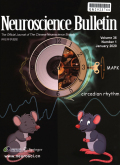- 钛学术文献服务平台 \
- 学术期刊 \
- 医药卫生期刊 \
- 神经病学与精神病学期刊 \
- 神经科学通报(英文版)期刊 \
null
A New Perspective for Parkinson's Disease: Circadian Rhythm
基本信息来源于合作网站,原文需代理用户跳转至来源网站获取
摘要:
Circadian rhythm is manifested by the behavioral and physiological changes from day to night,which is controlled by the pacemaker and its regulator.The former is located at the suprachiasmatic nuclei (SCN) in the anterior hypothalamus,while the latter is composed of clock genes present in all tissues.Circadian desynchronization influences normal patterns of day-night rhythms such as sleep and alertness cycles,rest and activity cycles.Parkinson's disease (PD) exhibits diurnal fluctuations.Circadian dysfunction has been observed in PD patients and animal models,which may result in negative consequences to the homeostasis and even exacerbate the disease progression.Therefore,circadian therapies,including light stimulation,physical activity,dietary and social schedules,may be helpful for PD patients.However,the cellular and molecular mechanisms that underlie the circadian dysfunction in PD remain elusive.Further research on circadian patterns is needed.This article summarizes the existing research on the circadian rhythms in PD,focusing on the clinical symptom variations,molecular changes,as well as the available treatment options.

推荐文章
期刊_丙丁烷TDLAS测量系统的吸收峰自动检测
带间级联激光器
调谐半导体激光吸收光谱
雾剂检漏 中红外吸收峰 洛伦兹光谱线型
不同盐度、温度及光照对漂浮浒苔生理生态的影响
浒苔
盐度
温度
光照
生理生态
期刊_联合空间信息的改进低秩稀疏矩阵分解的高光谱异常目标检测
高光谱图像
异常目标检测 低秩稀疏矩阵分解 稀疏矩阵 残差矩阵
内容分析
关键词云
关键词热度
相关文献总数
(/次)
(/年)
文献信息
| 篇名 | A New Perspective for Parkinson's Disease: Circadian Rhythm | ||
| 来源期刊 | 神经科学通报(英文版) | 学科 | |
| 关键词 | |||
| 年,卷(期) | 2017,(1) | 所属期刊栏目 | |
| 研究方向 | 页码范围 | 62-72 | |
| 页数 | 11页 | 分类号 | |
| 字数 | 语种 | 英文 | |
| DOI | 10.1007/s12264-016-0089-7 | ||
五维指标
引文网络
引文网络
二级参考文献 (193)
共引文献 (8)
参考文献 (114)
节点文献
引证文献 (0)
同被引文献 (0)
二级引证文献 (0)
1900(1)
- 参考文献(1)
- 二级参考文献(0)
1976(1)
- 参考文献(0)
- 二级参考文献(1)
1978(1)
- 参考文献(1)
- 二级参考文献(0)
1984(1)
- 参考文献(1)
- 二级参考文献(0)
1985(1)
- 参考文献(0)
- 二级参考文献(1)
1986(1)
- 参考文献(0)
- 二级参考文献(1)
1987(2)
- 参考文献(0)
- 二级参考文献(2)
1989(1)
- 参考文献(0)
- 二级参考文献(1)
1990(2)
- 参考文献(2)
- 二级参考文献(0)
1991(3)
- 参考文献(2)
- 二级参考文献(1)
1992(2)
- 参考文献(0)
- 二级参考文献(2)
1993(3)
- 参考文献(3)
- 二级参考文献(0)
1994(6)
- 参考文献(2)
- 二级参考文献(4)
1995(4)
- 参考文献(1)
- 二级参考文献(3)
1997(5)
- 参考文献(4)
- 二级参考文献(1)
1998(3)
- 参考文献(0)
- 二级参考文献(3)
1999(4)
- 参考文献(0)
- 二级参考文献(4)
2000(8)
- 参考文献(4)
- 二级参考文献(4)
2001(7)
- 参考文献(2)
- 二级参考文献(5)
2002(9)
- 参考文献(1)
- 二级参考文献(8)
2003(8)
- 参考文献(4)
- 二级参考文献(4)
2004(5)
- 参考文献(3)
- 二级参考文献(2)
2005(9)
- 参考文献(4)
- 二级参考文献(5)
2006(15)
- 参考文献(6)
- 二级参考文献(9)
2007(24)
- 参考文献(8)
- 二级参考文献(16)
2008(19)
- 参考文献(5)
- 二级参考文献(14)
2009(15)
- 参考文献(6)
- 二级参考文献(9)
2010(29)
- 参考文献(7)
- 二级参考文献(22)
2011(18)
- 参考文献(6)
- 二级参考文献(12)
2012(22)
- 参考文献(7)
- 二级参考文献(15)
2013(30)
- 参考文献(8)
- 二级参考文献(22)
2014(29)
- 参考文献(8)
- 二级参考文献(21)
2015(12)
- 参考文献(11)
- 二级参考文献(1)
2016(7)
- 参考文献(7)
- 二级参考文献(0)
2017(0)
- 参考文献(0)
- 二级参考文献(0)
- 引证文献(0)
- 二级引证文献(0)
引文网络交叉学科
相关学者/机构
期刊影响力
神经科学通报(英文版)
主办单位:
中国科学院上海生命科学研究院
出版周期:
双月刊
ISSN:
1673-7067
CN:
31-1975/R
开本:
16开
出版地:
上海市岳阳路319号31B楼405室
邮发代号:
4-608
创刊时间:
1985
语种:
eng
出版文献量(篇)
2003
总下载数(次)
1
总被引数(次)
9688
期刊文献
相关文献
推荐文献
- 期刊分类
- 期刊(年)
- 期刊(期)
- 期刊推荐
神经科学通报(英文版)2022
神经科学通报(英文版)2021
神经科学通报(英文版)2020
神经科学通报(英文版)2019
神经科学通报(英文版)2018
神经科学通报(英文版)2017
神经科学通报(英文版)2016
神经科学通报(英文版)2015
神经科学通报(英文版)2014
神经科学通报(英文版)2013
神经科学通报(英文版)2012
神经科学通报(英文版)2011
神经科学通报(英文版)2010
神经科学通报(英文版)2009
神经科学通报(英文版)2008
神经科学通报(英文版)2007
神经科学通报(英文版)2006
神经科学通报(英文版)2005
神经科学通报(英文版)2004
神经科学通报(英文版)2003
神经科学通报(英文版)2002
神经科学通报(英文版)2001
神经科学通报(英文版)2000
神经科学通报(英文版)2017年第6期
神经科学通报(英文版)2017年第5期
神经科学通报(英文版)2017年第4期
神经科学通报(英文版)2017年第3期
神经科学通报(英文版)2017年第2期
神经科学通报(英文版)2017年第1期

 免费查重
免费查重










